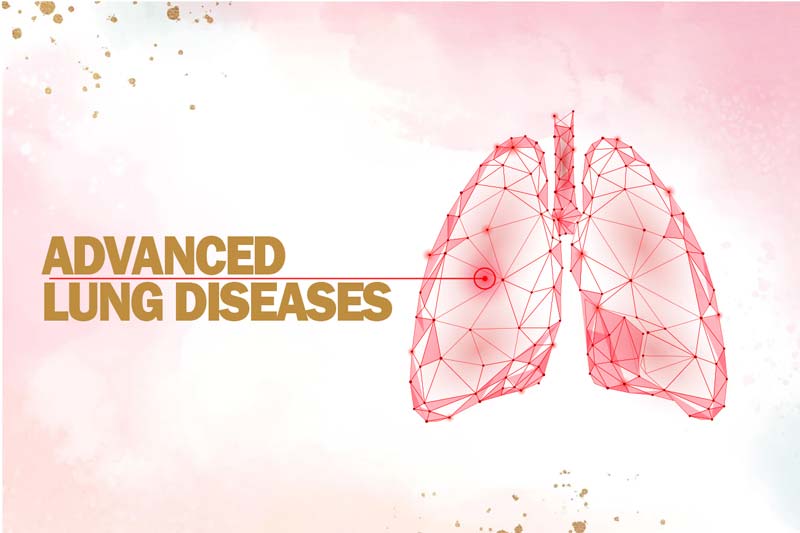Advanced Lung Diseases


Lung diseases are one of the major health concerns world-wide, causing premature deaths of nearly 4 million people each year. Advanced lung diseases or end-stage lung diseases, as they are called, can affect lung functions severely, affecting the air flow and the flow of blood in and out through the lungs.
Advanced lung diseases are grouped into five broad categories:
One of the major causes of advanced lung diseases is COPD (chronic obstructive pulmonary diseases), caused by obstructive airways.
Emphysema is one of the common chronic obstructive diseases that cause destruction of lung tissues over time. It limits the lung’s capacity of transferring oxygen into the blood and causes many distressing respiratory symptoms like shortness of breath, wheezing and continuous coughing.
Bronchiectasis is another chronic obstructive lung disease that causes recurrent infections and damage to lung tissues. In this disease condition, breathing airways become irreversibly thickened and damaged. This leads to loss of lung function in the long run.
These are another group of diseases that come into the category of advanced lung diseases. Over 200 lung disease conditions that result in scarring of lung tissues are grouped as Interstitial lung diseases. Scarring of lung tissues leads to less oxygen entering the bloodstream and causes breathlessness and other respiratory symptoms.
Various reasons like exposure to toxic substances, medical conditions like (rheumatoid arthritis and scleroderma) and use of some drugs (like chemotherapy drugs) can cause interstitial pulmonary diseases. Sometimes, the cause of interstitial lung diseases is difficult to ascertain. Such a condition is called “Idiopathic interstitial lung disease”. It is also one of the commonly known interstitial lung diseases.
Interstitial pulmonary diseases cause irreversible and progressive pathological changes in lung tissues; however, treatment and proper management can help slow disease progression and improve quality of life.
PVD is the medical term for disease affecting the blood vessels leading to or from the lungs. Most forms of pulmonary vascular disease cause shortness of breath. You can get PVD from your parents or develop it on your own. Often, it has no apparent cause. People with this condition struggle to get oxygen into their blood. PVD covers many illnesses. Some develop slowly over decades. Others are immediately fatal.
Scarring and fibrosis of lung tissue characterize pulmonary fibrosis. The other common cause of pulmonary fibrosis is exposure to toxic substances or lung irritants, certain medications and treatments (like radiation and chemotherapy). Certain medical conditions like pneumonia and rheumatoid arthritis may cause pulmonary fibrosis. Pulmonary fibrosis cause lung damage that cannot be repaired, resulting in advanced lung diseases.
Certain genetic diseases like cystic fibrosis (CF) are an inherited disease in which the body makes very thick, sticky mucus. The mucus causes problems in the lungs, pancreas, and other organs. People with cystic fibrosis are regularly affected by lung infections. Over time, they have more trouble breathing. They also have digestive problems that make it hard to gain weight.
The signs and symptoms of advanced lung diseases can depend on the underlying medical conditions. Most of the advanced lung diseases cause common symptoms, like:
Advanced lung diseases get worse over time and have a poor prognosis. They lead to poor quality of life, reduced life expectancy and could be fatal without proper management.
Following are the major risk factors for developing advanced lung diseases:
Chronic obstructive pulmonary diseases, interstitial pulmonary diseases, pulmonary vascular diseases, pulmonary fibrosis, cystic fibrosis and pulmonary embolism are some of the common severe lung diseases. These diseases are also called advanced or end-stage lung diseases. These diseases affect lung functionality severely and disable lung functions in the long run.
Yes, advanced lung diseases are threatening. Many advanced lung diseases affect lung functions adversely and cause irreversible changes in the lung tissues. Apart from distressing respiratory symptoms (like breathlessness, severe fatigue), advanced lung diseases also cause a state of fear, anxiety, depression and social isolation in many patients, putting a negative impact on the quality of life. Proper treatment and disease management can improve the quality of life and life expectancy.
Generally, patients with advanced lung diseases have severely low lung function. It can lead to the need for additional oxygen support and a mechanical ventilator to support the breathing and lung functions.
The treatment options for advanced lung diseases are limited, but ongoing medical support and palliative care (such as pulmonary rehabilitation) can help in improving life expectancy and quality of life.
Lung transplant is the only curative treatment option for advanced lung patients, but it has its own set of challenges, such as graft rejections and lack of availability of donor lung. However, most times, lung transplant can be a lifesaving procedure and can increase the life expectancy of advanced lung disease patients up to a certain level.
© 2025 Healthy Lungs.